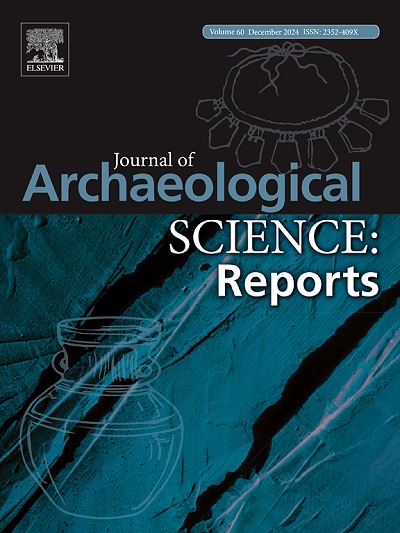Multi-parametric µMRI and Synchrotron radiation-based XPCT for studying human bone tissue in archaeological contexts
IF 1.5
2区 历史学
0 ARCHAEOLOGY
引用次数: 0
Abstract
In this study, the microporosity and the microstructural topology of archaeological cortical bones from a Roman necropolis, dated to the 1st-3rd century CE, were investigated using two approaches: a direct method based on Synchrotron radiation-based X-ray phase contrast tomography (SXPCT) images and an indirect method, based on a model to extract pore size utilizing data derived from Magnetic Resonance micro-imaging (µMRI) weighted in T2 relaxation times and molecular diffusion.
This study aimed to understand the interchangeability of these techniques, i.e. whether they provide the same or complementary information. To validate this, a multiscale approach based on High resolution SXPCT and µMRI was performed on the same samples and compared the results.
The study was carried out on three archaeological tibia samples. One of these samples was affected by periostitis, one was healthy and in a good state of preservation and one showed strong signs of post-mortem degradation. This selection was made by surface inspection of the bone samples by an expert archaeologist. The potential value of subsurface and volumetric examination using two non-destructive tomographic techniques based on X-ray and Nuclear Magnetic Resonance will be investigated. Since the SXPCT technique is well established for microscopic studies of archaeological bones, but its cost is significantly higher than a µMRI examination and its access is limited, a comparison of the SXPCT and µMRI results was made, highlighting their agreement, differences and complementarities.
The pore size dimension obtained by µMRI, is underestimated compared to that obtained by SXPCT, which agrees with the literature. This is due to the high value of magnetic susceptibility differences between the bone matrix and water inside the pores, which increases with the magnetic field. To extract pore sizes by µMRI, relaxivities were quantified at 9.4 T. The relaxivity value of the periostitis sample was significantly lower than that of healthy and taphonomic samples. Relaxivity depends on several factors, not only related to nano-micromorphology of pore walls, but also related to bone chemical and biochemical constituents. For this reason, it is suggested that the interplay between its values, together with the internal microstructure immediately below the bone surface, could indicate the origin of periostitis lesions, from trauma and hard work, or from bacterial infections. SXPCT allows 3D visualization of Haversian canals, which appear less ordered and have a smaller cross-sectional area in the periostitis sample compared to healthy and taphonomic samples.
多参数微MRI和基于同步辐射的XPCT在考古背景下研究人类骨组织
在这项研究中,研究人员使用两种方法研究了公元1 -3世纪罗马墓地考古皮质骨的微孔隙度和微观结构拓扑:一种是基于同步辐射的x射线相对比断层扫描(SXPCT)图像的直接方法,另一种是基于基于磁共振微成像(µMRI)的模型提取孔径的间接方法,该模型利用T2弛豫时间和分子扩散加权数据。本研究旨在了解这些技术的互换性,即它们是否提供相同或互补的信息。为了验证这一点,在相同的样品上进行了基于高分辨率SXPCT和µMRI的多尺度方法,并比较了结果。这项研究是在三个考古胫骨样本上进行的。其中一个样本受到骨膜炎的影响,一个是健康的,保存状态良好,一个显示出强烈的死后降解迹象。这一选择是由一位考古学专家对骨骼样本进行表面检查后做出的。使用基于x射线和核磁共振的两种非破坏性层析成像技术进行地下和体积检查的潜在价值将进行研究。由于SXPCT技术在考古骨骼的显微研究方面已经建立起来,但其成本明显高于µMRI检查,并且其访问受到限制,因此对SXPCT和µMRI结果进行了比较,突出了它们的一致性,差异性和互补性。与SXPCT相比,µMRI获得的孔径尺寸被低估,这与文献一致。这是由于骨基质和孔隙内的水之间的高磁化率差异,随着磁场的增加而增加。为了通过µMRI提取孔隙大小,将松弛度量化为9.4 t。骨膜炎样本的松弛度值明显低于健康和非骨膜炎样本。松弛度取决于几个因素,不仅与孔壁的纳米微形态有关,而且与骨化学和生化成分有关。因此,我们认为其值之间的相互作用,以及骨表面以下的内部微观结构,可能表明骨膜炎病变的起源,来自创伤和艰苦的工作,或者来自细菌感染。SXPCT允许三维可视化哈弗氏管,与健康和肿瘤样本相比,在骨膜炎样本中,哈弗氏管看起来不那么有序,横截面积更小。
本文章由计算机程序翻译,如有差异,请以英文原文为准。
求助全文
约1分钟内获得全文
求助全文
来源期刊

Journal of Archaeological Science-Reports
ARCHAEOLOGY-
CiteScore
3.10
自引率
12.50%
发文量
405
期刊介绍:
Journal of Archaeological Science: Reports is aimed at archaeologists and scientists engaged with the application of scientific techniques and methodologies to all areas of archaeology. The journal focuses on the results of the application of scientific methods to archaeological problems and debates. It will provide a forum for reviews and scientific debate of issues in scientific archaeology and their impact in the wider subject. Journal of Archaeological Science: Reports will publish papers of excellent archaeological science, with regional or wider interest. This will include case studies, reviews and short papers where an established scientific technique sheds light on archaeological questions and debates.
 求助内容:
求助内容: 应助结果提醒方式:
应助结果提醒方式:


